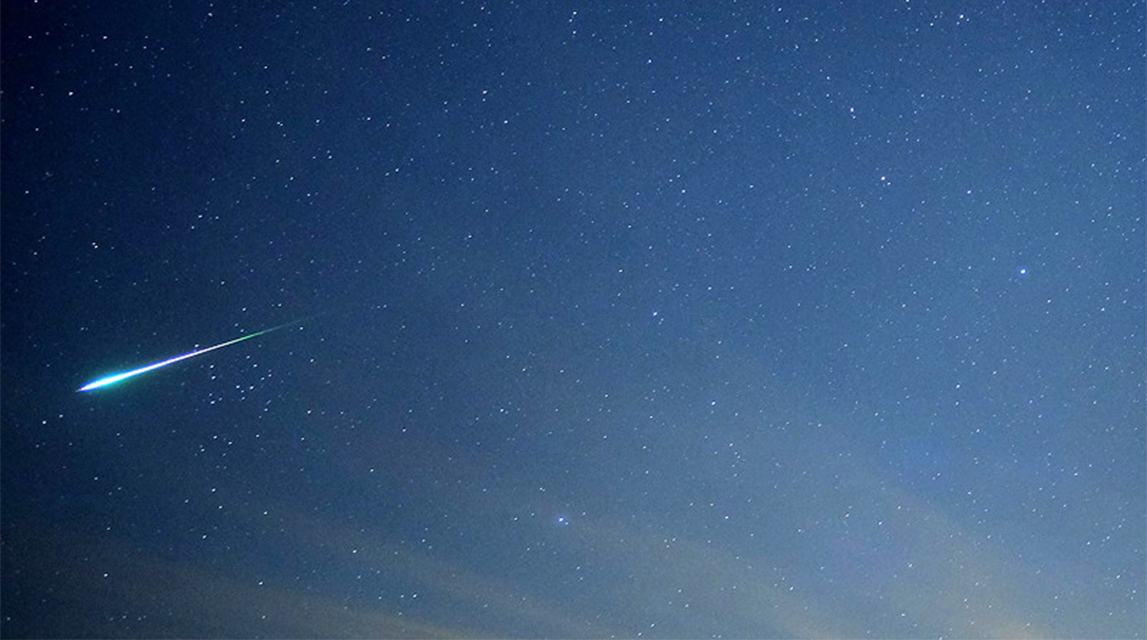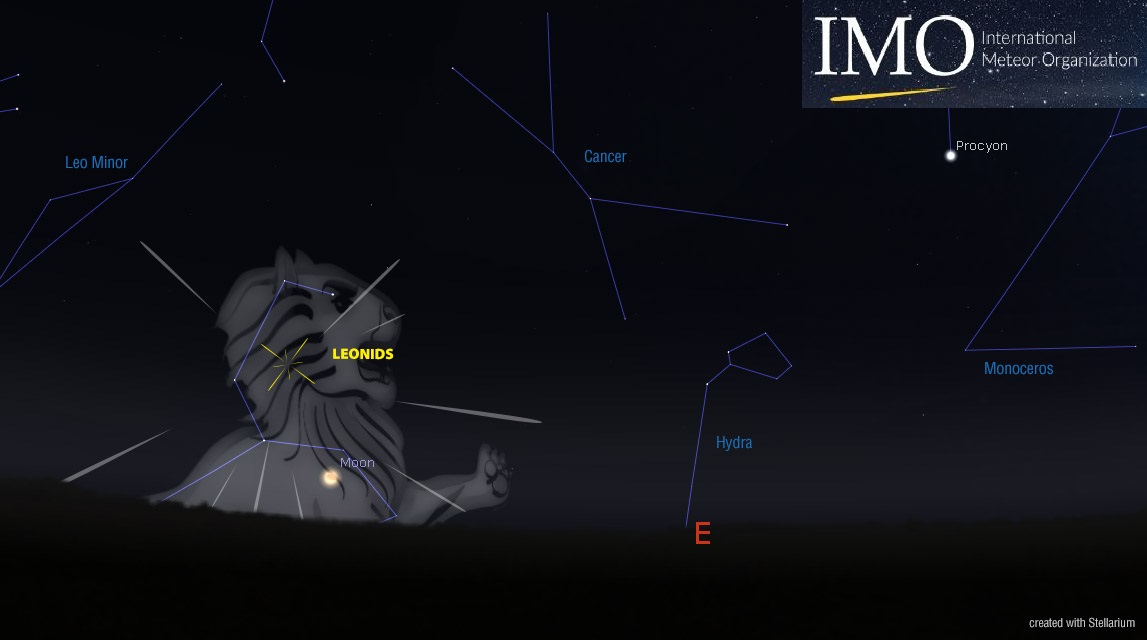 Paul Sutherland captured this Leonid fireball from Walmer, Kent, England, on 19 November 2017 at 02h29m09s UT. The path leads back to the radiant, located in the “Sickle of Leo”. The colors are actually produced by the meteor passing though the air and ionizing the oxygen and nitrogen molecules. © Paul Sutherland .
Paul Sutherland captured this Leonid fireball from Walmer, Kent, England, on 19 November 2017 at 02h29m09s UT. The path leads back to the radiant, located in the “Sickle of Leo”. The colors are actually produced by the meteor passing though the air and ionizing the oxygen and nitrogen molecules. © Paul Sutherland .The Leonids are remnants of comet 55P Tempel-Tuttle, which last passed through the inner solar system in 1998. The comet has just passed its farthest point from the sun and is now on its inbound leg of its journey around the sun. It is expected to be closest to the sun again in 2031. The comet has completed so many trips around the sun that remnants are encountered on Earth every November, regardless of the position of the comet. Each journey around the sun produces its own unique path and the Earth often passes close to this paths each year. In 2022, the nodal crossing occurs near 23:00 universal time (UT) on November 17th. This is when the Earth passes closest to the core of the many debris streams. This is normally when maximum activity occurs with rates usually around 15 Leonids per hour seen during the latter half of the morning. In addition to the nodal crossing, the Earth is predicted to pass close to the path created in the year 1733 between 06:00 and 06:30 UT on November 19th. This corresponds to 1:00-1:30am EST on Saturday morning November 19th. An increase of bright Leonid activity may occur in this time span, which is favorable for viewers located in the eastern half of North America and most of South America. Some excessive rates have been quoted in other journals, but the true strength of this possible outburst is unknown. The length of the possible outburst is also unknown. It may be only a few minutes long as the Earth passes quickly though these debris fields. Two weaker encounters are also predicted at 7:00 UT on November 18th (2:00am EST) and at 15:00 UT on November 21st.*
The source (radiant) of the Leonid meteors lies in the “sickle” of Leo near the star named Algieba (gamma Leonis). This area of the sky rises in the east between 23:00 and midnight for most of the world. Therefore no Leonid meteors may be seen during the early evening hours when the source lies far below the horizon. As the midnight hour approaches some Leonid activity may be seen shooting upwards from the eastern horizon. The best views of this display occurs during the last two hours prior to dawn when the source lies highest above the horizon in a dark sky. Leonid meteors may be seen in any portion of the sky but it would be wise to concentrate your view in the eastern half where Leonid meteors can be seen shooting in all directions. Luckily, the Leonid meteors may be seen in both hemispheres but the northern hemisphere is favored by the source being located higher in the sky and a longer night this time of year. In 2022, the moon will be a waning crescent phase, not far from the radiant. This positioning will make it difficult to see any faint Leonids. It may be best to face halfway up in the southern sky if the moon lies above the horizon. If the moon has not risen, then facing eastward is recommended.

Viewing meteor activity is a great way to easily contribute to science by being a citizen scientist. In order to produce scientifically useful data it is suggested to view for at least one hour and provide shower associations with each meteor you witness. The reason for this is to allow your eyes to become accustomed to the darkness. The longer viewing sessions also allows you to witness the peaks and valleys of meteor activity, as meteors seem to appear in spurts and are not constant. It also is necessary to provide us with the magnitude of the faintest star you can see so that we can determine the darkness of your sky. This allows us to make adjustments so that all observations can be directly compared to one another. Making magnitude estimates is easily done by counting the number of stars visible within certain areas of the sky – see also https://www.imo.net/observations/methods/visual-observation/ and here for more tips on viewing meteor showers. In order to share your observations we suggest that you fill out a visual meteor report form provided by the International Meteor Organization. You must register to provide your data, but there is a free option for those not wishing to subscribe to the IMO Journal. We wish you good luck and look forward to seeing your viewing results!
*Reference: 2022 Meteor Shower Calendar By Juergen Rendtel, pages 17-18. https://www.imo.net/files




 You saw something bright and fast? Like a huge shooting star? Report it: it may be a fireball.
You saw something bright and fast? Like a huge shooting star? Report it: it may be a fireball.  You counted meteors last night? Share your results with us!
You counted meteors last night? Share your results with us!  You took a photo of a meteor or fireball? You have a screenshot of your cam? Share it with us!
You took a photo of a meteor or fireball? You have a screenshot of your cam? Share it with us!  You caught a meteor or fireball on video? Share your video with us!
You caught a meteor or fireball on video? Share your video with us!